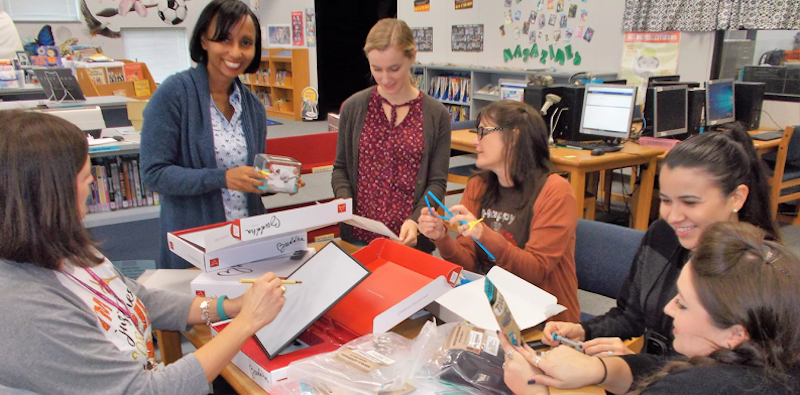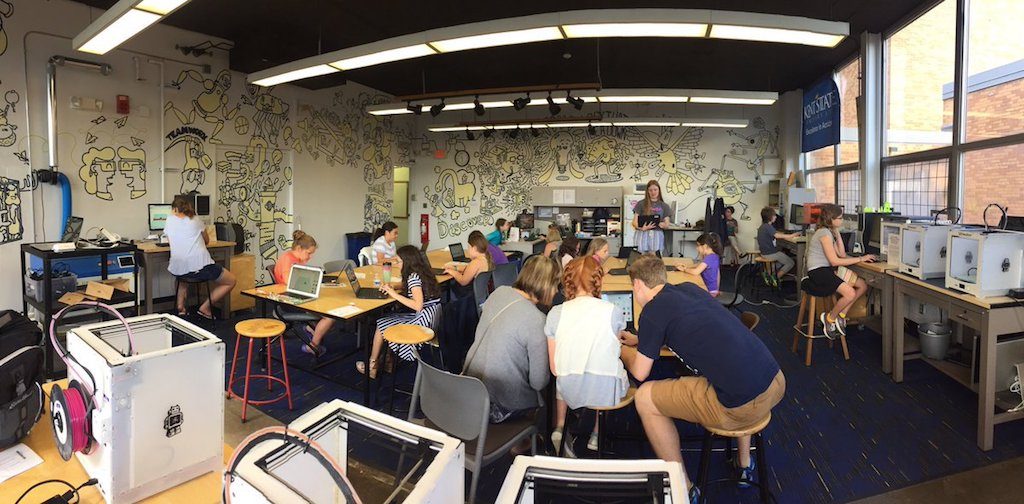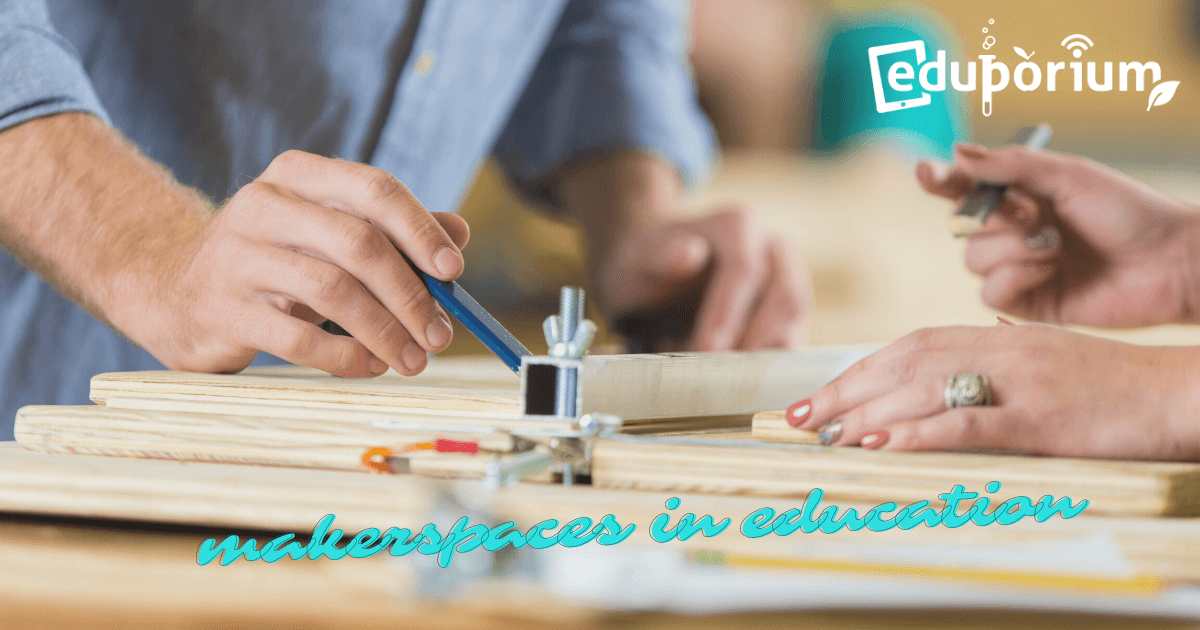What is it that makes school makerspaces so great? Is it the technology that teachers introduce students to? Is it the new opportunities for real-world engagement? Or, is it something else? Truthfully, it is probably a combination of all three elements with other smaller pieces that each help teachers manage high-impact learning. There's no one recipe for creating the best makerspace but there are things teachers can do to help set theirs apart and facilitate high-quality learning experiences. Whether a makerspace is large, small, stationary, mobile, formal, or informal, these are some traits that effective makerspaces share.
A Makerspace Where Students Feel Free
When we say that makerspaces should be free, it's true that we don’t want people to have to pay to use a makerspace—especially students—but that is not what we mean here. We think that makerspaces should open up all kinds of freedoms for students to try all sorts of new things. Ideally, makerspace experiences should free things up and allow kids to move away from traditional learning towards something new. These experiences can help remove some classroom restrictions on creativity and give students more freedom to create—however they'd like. Makerspace learning is about trying new things, collaborating, being creative, and probably failing at least a handful of times. Children should all feel empowered by that kind of freedom and know that it’s welcomed in the makerspace.
The freedom to create with grade-related pressures.
With the freedom to create comes all kinds of innovative learning and invention opportunities. And, after all, that's pretty much what school makerspaces are all about. Not having restrictions in their learning can help students become more willing to try new things. Removing the grades and pressures that they might feel is also very liberating for them. We have talked about gradeless classrooms before and makerspaces create opportunities to incorporate that style in your school. It definitely goes a long way in helping equip students with the mindset that they can absolutely try something new (and maybe even a bit unique) as long as they do so purposefully. Who knows—maybe they’ll find a whole new way to complete a project or assignment.
Makerspace freedom and student success.
Creative freedom is such an important piece of 21st century learning. Since there's not always a dedicated makerspace curriculum in schools, children often are extra creative while in makerspaces. Then, they can take those creative approaches they’ve discovered in the makerspace and use them throughout their other classes. Their teachers and librarians who lead makerspace learning have a big role in creating this kind of freedom. They can affect this by carefully choosing the tech tools and creative materials they'll bring into the makerspace environment. They can also consider the messages they want to pass on to their students. And, they can, of course, lead by example and show students that, as they take advantage of the freedom they find in a makerspace, they can accomplish some increasingly amazing things.
Creating Opportunities for Collaboration
Some of the most creative ideas are born from collaboration, right? Since students have every opportunity to be creative in makerspaces, it could double or triple when working with peers. Plus, most of the projects that students create in makerspaces are naturally collaborative or, at the very least, educators can redesign them to include different roles and responsibilities that lead to more chances for them to collaborate. When you think about it, students can create so many different things in a makerspace and collaborating unlocks more opportunities. So, making way for collaboration is something that makerspace teachers often work to prioritize and students tend to benefit.
How to create collaboration in a makerspace.
So many different tools allow for collaboration in makerspaces, giving educators a lot of freedom (of their own) in deciding what to use. There are options that are both high- or low-tech with affordable products for any budgets. Sure, higher-end technologies, like educational 3D printers, could improve collaboration but simple things (construction paper, scissors, and glue) can, too. Collaboration doesn’t need to be expensive or even high tech in order to mimic the real world. For those who are new to makerspace teaching, you can even opt to keep it on the simple side. Whatever technologies you (and your students) are comfortable with are probably best—you just have to figure out what those are and find things they can use together.
Technology and adjacent components that facilitate collaboration.
Designing spaces that invite collaboration is key for students sharing ideas in the makerspace. And, while it’s not completely necessary, innovative technology tools will likely play a central role in accelerating the collaboration. Makerspace facilitators should keep in mind, however, that their space still needs things like power outlets, seating, and space for students to work, like tables or the floor. With enough space to work and experiment, the collaboration should then come fairly naturally. Also, when deciding on technology for a makerspace, it can be high-tech or low-tech but anything that helps facilitate collaboration is something you’ll probably want to explore since a collaborative makerspace is one we can certainly get behind.

Making Sure the Makerspace is Adaptable
One word often associated with school makerspaces and the learning within them is versatility. Leveraging versatile EdTech tools unlocks learning experiences that could take almost any shape and go in almost any direction. Since makerspaces are home to all different types of learning, which often evolve over the course of weeks, days, or even hours, it's ideal that your physical setup is adaptable. Your interpretation of exactly what 'adaptive' means is entirely up to you and can include small adjustments or large overhauls. Ideally, a school makerspace would house both furniture and tech tools that teachers can move around, store easily, and use to facilitate different types of active learning for students.
Staying within your resources in makerspace design.
In terms of adaptability, educators can design makerspaces to align with space or budgetary requirements. Starting with space, some schools have plenty of space for building makerspaces in the library or even in another room. Not every school will be like that, however, so some makerspace teachers need to maximize a smaller space at times. Since they, of course, would still like to do lots of the same makerspace activities and exercises despite having a smaller space, they have to adapt their lessons, objectives, and the desired outcomes in some cases. That is why researching which MakerEd tools are easily transported, integrated, charged, and adaptable is worthwhile.
Unique makerspace features and set-up.
If you have access to moving furniture, shelves, or walls, those are also great assets. With a moving shelf, for example, makerspace teachers could set up a movable barrier to contain students in your makerspace or allow for other classes to learn on the other side of the wall without any interruptions. Movable desks or chairs also allow children to work together more effectively and take their projects and materials with them throughout the makerspace. And, finally, as students work together and develop new skills, they are going to want to continue expanding on them. So, if a makerspace helps teachers create student growth, it also embodies adaptability and helps them prepare for the future.
Creating a Welcoming Environment for Creative Exploration
One of the biggest criticisms that the Maker Movement and STEAM education in general face is a lack of inclusion. Statistics indicate that the STEM workforce is dominated by men—though that gap is shrinking a bit. As school and district leaders make conscious efforts to reduce gender barriers, we hope this won’t always be a problem. In the past, however, girls and members of some minority groups haven’t always felt welcomed in these types of environments. The Maker Movement is supposed to bring everybody together, however, so much of the discrimination hopefully is not even intentional. Just by making a conscious effort to make makerspaces more inclusive, however, instructors can unlock greater learning opportunities when everyone feels welcome to contribute.
Fostering inclusion in a school makerspace.
To make the school or library makerspace more inclusive, you don’t have to do anything drastic or reinvent the wheel. Learning should be equitable and inclusive anyway and there's many examples of welcoming learning environments that teachers can imitate. As those who embody the spirit of the Maker Movement believe, making truly is for everyone. So, one of the most obvious (and, to be honest, easiest) ways to truly expand inclusion is if school makerspace leaders design projects or events specifically for girls. There are girls in every school, so designing initiatives that appeal directly to their educational and STEAM interests is a good place to start when making things more welcoming. And, hopefully, this could also get them to return to the makerspace more frequently.
Designing projects to make everyone feel welcomed.
Not every student knows what the Maker Movement is or that they can use technology or random objects for learning and creative development. So, makerspace leaders could focus on engaging any underserved students with introductory programs to help get them more comfortable with this type of environment and using new technologies. Teachers can also engage students who have different ethnic backgrounds using purposefully designed makerspace activities. Maybe they're as simple as creating projects on prominent historical figures that share the same ethnicity as them. For any students with the same ethnicity, they can collaborate and learn more about their heritage while creating together. These are just some examples but making your makerspace welcoming to every student makes it more likely that they keep coming back.

Makerspace Experiences with an Academic Side
While makerspace experiences certainly can be fun, when we look at this impact, we'll never want to lose sight of advancing learning and helping all students grow. Fortunately, most makerspace experiences also have academic benefits no matter how informal, low-key, or completely void of a makerspace curriculum they may be. One way to make sure your makerspace fun is still educational is designing specific projects. With these challenges, teachers can encourage kids to work through specific problems and apply specific skills in solving them. This is also an opportunity to tie these challenges to standards to help drive deeper learning and align making to what students need to learn.
Helping students develop a maker mindset.
When kids explore in makerspaces, they might use certain approaches for projects and overcoming design challenges. We call this a maker mindset, which correlates to how makers tackle these various challenges creatively. The great thing about students developing a maker mindset is that they can then use it within all aspects of their education—not just in the makerspace. When thinking like a maker, students might assess challenges from multiple viewpoints and consider many different outcomes while weighing the best way to try solving it. And, this is a great way for kids to carry what they learn in makerspaces into other subjects.
Using makerspace experiences as foundations for growth.
We believe it's important for teachers to understand the concept of a maker mindset and how it can benefit children. With this knowledge, they'll often find more willingness to adopt any makerspace activities in their classroom or try new things in their makerspace using what they’ve learned to fuel added innovation. Once students buy in to utilizing a maker mindset in and out of the makerspace, they'll also develop additional skills. Like we’ve already discussed, makers are naturally collaborative—something that kids get to explore when they adopt the maker mindset. They could even learn the values of being persistent, creative, willing to fail, and willing to try new things. All of these constitute progress in terms of maker learning and learning in general and they're great things to embody in your school or library makerspace.
For the latest EdTech, STEM, and 21st century education news, follow us on Twitter and Instagram. Like us on Facebook, too, or sign up for our newsletter for our latest product announcements and offerings. If you have an idea for an Eduporium Weekly theme, send us a message on social media or comment below.



